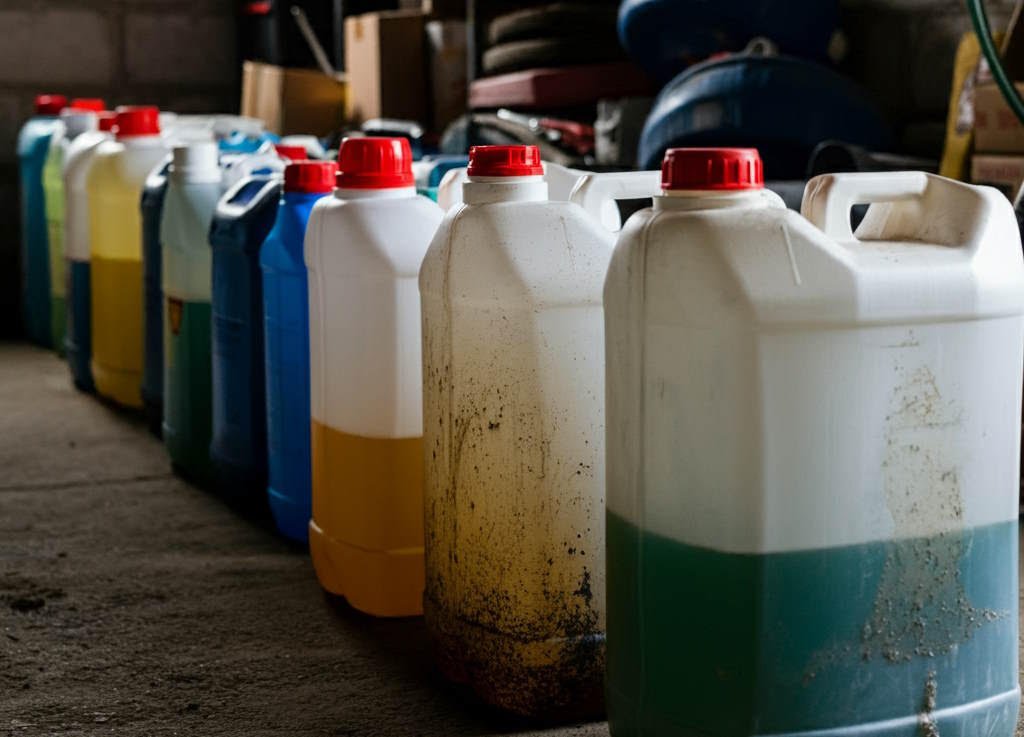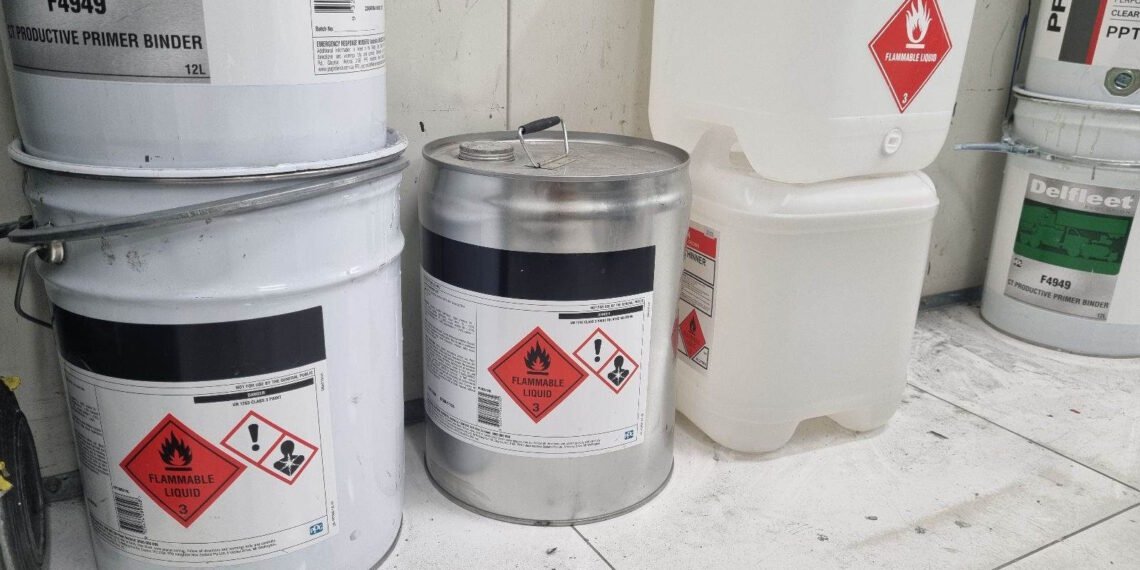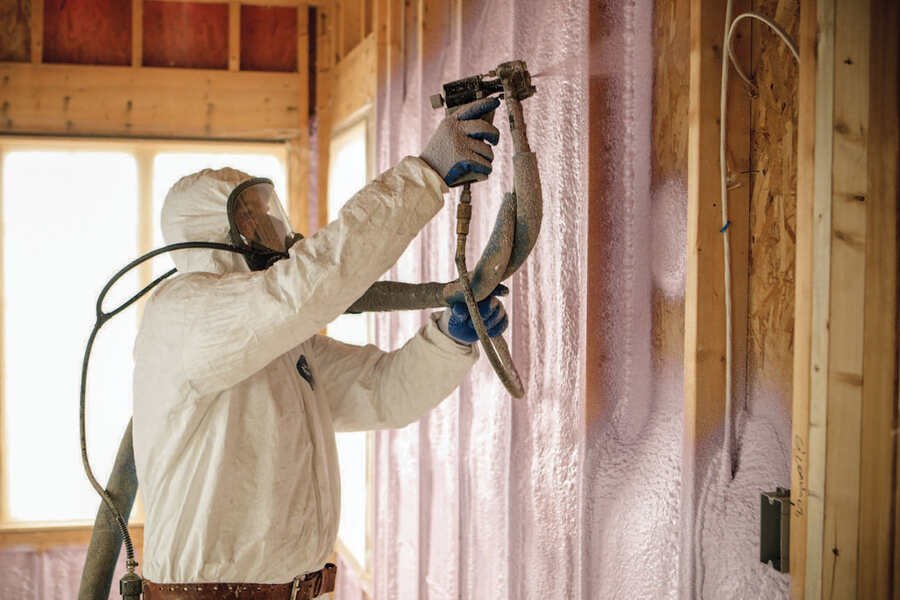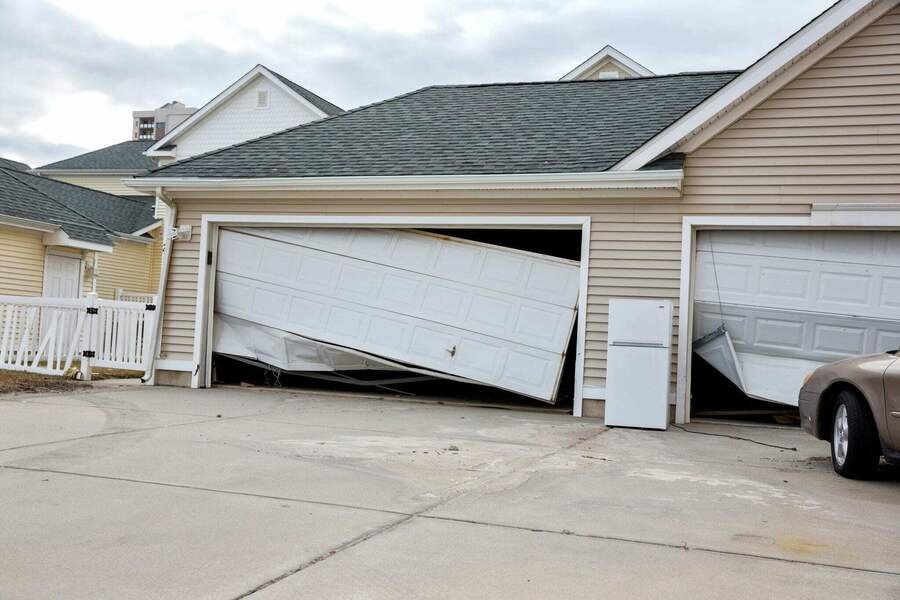As a homeowner, you likely have loads of chemicals stored in your house, garage and shed for cleaning, maintenance, hobbies and other purposes. These products make our lives easier, but they can pose significant risks if not stored properly. One of the most overlooked dangers is the potential for harmful reactions when incompatible chemicals are stored together – this could result in noxious chemicals and even explosions or fires. Let’s take a look at the importance of proper chemical storage, some examples of common household chemicals that shouldn’t mix, and some guidance on safe storage practices.
People working in businesses often have dangerous goods training, but the general public almost never has any experience.
Understanding Chemical Classifications
Chemicals are classified into different classes based on their properties and potential hazards; you might have seen the diamond-shaped warning labels on products and packaging. Some common classifications you might encounter in household products include:
- Flammable liquids (Class 3)
- Flammable solids (Class 4.1)
- Oxidizing substances (Class 5.1)
- Toxic substances (Class 6.1)
- Corrosive substances (Class 8)
These classifications help identify which chemicals can be safely stored together and which need to be kept separate. It’s the reason why you should do things like mix cleaning products together, because they can react with one another.
Common Household Chemicals and Their Incompatibilities
Let’s look at some everyday household items that fall into these categories and shouldn’t be stored together:
- Bleach (sodium hypochlorite) and ammonia-based cleaners:
Bleach is an oxidizing agent (Class 5.1), while ammonia-based cleaners are often corrosive (Class 8). When mixed, they can produce toxic chloramine gas. Keep these products well separated in your cleaning supplies.
- Pool chemicals and fertilizers:
Many pool chemicals, such as calcium hypochlorite, are strong oxidizers (Class 5.1). Fertilizers often contain ammonium nitrate, which can be explosive when mixed with oxidizers. Store pool chemicals and fertilizers in separate areas of your garage or shed.
- Acetone-based nail polish remover and hydrogen peroxide:
Acetone is highly flammable (Class 3), while hydrogen peroxide is an oxidizer (Class 5.1). Mixing these can create a potentially explosive compound. Keep your beauty products and first-aid supplies in separate locations.
- Drain cleaners and oven cleaners:
Both of these are typically corrosive (Class 8) but may have different chemical compositions. Mixing various corrosive chemicals can generate heat and potentially harmful fumes. Store these cleaning products separately.
- Gasoline and pool chlorine:
Gasoline is highly flammable (Class 3), while pool chlorine is an oxidizer (Class 5.1). This combination can be extremely dangerous and potentially explosive. Never store these items near each other in your garage or shed.
Chemicals Often Stored in Larger Quantities
Most chemicals are going to be stored in small quantities – what is often termed DGLQs or ‘dangerous goods in limited quantities,’ and there is a low risk of any reaction. However, some chemicals or chemical groups are sometimes stored in larger amounts at home, particularly in garages or sheds. These may include:
- Gasoline or diesel for lawnmowers and other equipment
- Paint and paint thinners
- Pesticides and herbicides
- Fertilizers
- Pool chemicals
- Automotive fluids (motor oil, antifreeze, brake fluid)
The storage of these items in larger quantities increases the potential risk if incompatible chemicals are kept too close together. For example:
- Oil-based paints and thinners (Class 3) should be kept separate from oxidizing substances like pool chemicals or certain fertilizers.
- Pesticides (which may fall under Class 6.1 – Toxic substances) should be stored away from flammable liquids and oxidizers.
Safe Storage Practices

To minimize risks associated with chemical storage, consider the following guidelines:
- Read labels carefully: Product labels often provide storage instructions and warnings about incompatible materials.
- Use proper containers: Keep chemicals in their original containers whenever possible. If you must transfer a product, use a container designed for that specific type of chemical.
- Implement a segregation system: Use the information from the supplier to create separate storage areas for different classes of chemicals. For example, store flammable liquids (Class 3) in a dedicated, well-ventilated cabinet, and keep oxidizers (Class 5.1) in a separate area, away from flammable and combustible materials.
- Provide adequate ventilation: Ensure your storage areas, especially for flammable liquids and toxic substances, have proper ventilation to prevent the buildup of fumes.
- Use secondary containment: For liquid chemicals, consider using trays or bins to catch potential leaks and prevent incompatible substances from mixing if spills occur.
- Regular inspections: Periodically check your chemical storage areas for signs of leaks, corrosion, or damaged containers. Dispose of any expired or deteriorating products properly.
- Keep chemicals out of reach: Store all potentially hazardous chemicals out of reach of children and pets, preferably in locked cabinets or high shelves.
- Maintain a safe environment: Keep your storage areas dry and at a moderate temperature. Extreme heat or cold can cause some chemicals to become unstable or react.
Limitations and Considerations
While proper storage is crucial, it’s important to recognize that there are limitations to what can be safely stored at home:
- Quantity limits: Some localities have regulations limiting the amounts of certain chemicals that can be stored in residential areas. Check with your local fire department or housing authority for specific guidelines.
- Professional storage: For large quantities or particularly hazardous materials, consider professional storage options or more frequent disposal rather than long-term home storage.
- Disposal challenges: Proper disposal of household chemicals can be difficult. Many cannot be thrown in the regular trash or poured down drains. Research local hazardous waste disposal options in your area.
- Climate considerations: If you live in an area prone to flooding, earthquakes, or extreme temperatures, take extra precautions in your chemical storage to prevent accidental mixing or release during natural disasters.
Conclusion
Of course, it’s usually only in the event of a leak or spill that there would be danger, but the safe storage of household chemicals is an often overlooked aspect of home safety. By understanding the potential risks of incompatible chemical storage and implementing proper segregation and storage practices, you can significantly reduce the risk of accidents, fires, or harmful chemical reactions in your home. Remember, when in doubt about the compatibility or safe storage of a particular chemical, consult the product’s Safety Data Sheet (SDS) or contact the manufacturer for specific guidance.
















